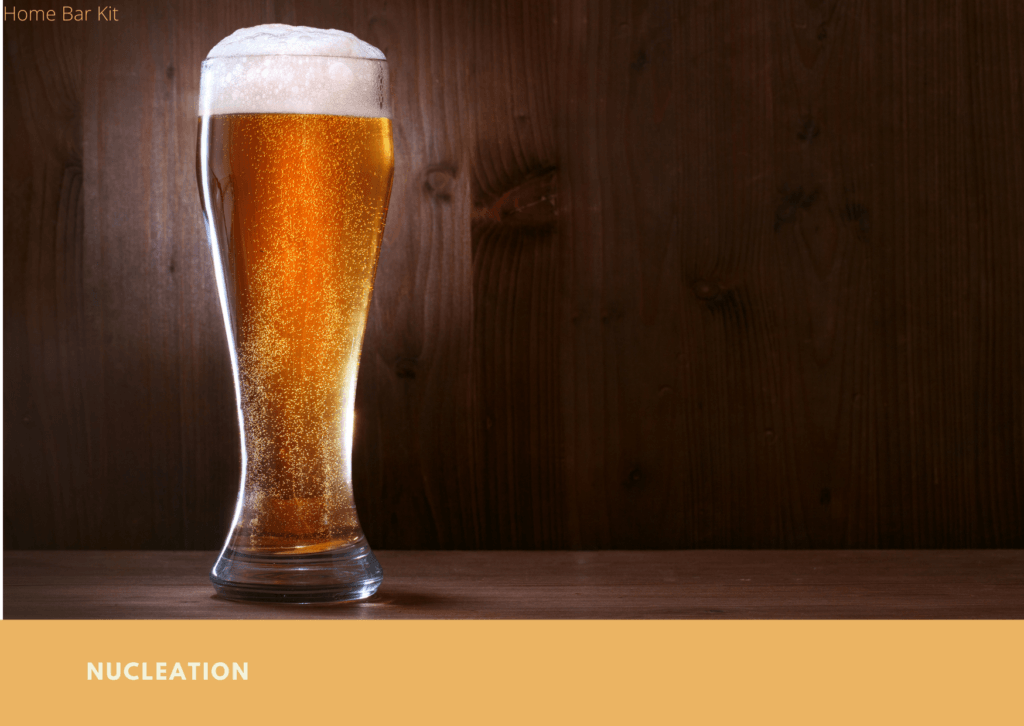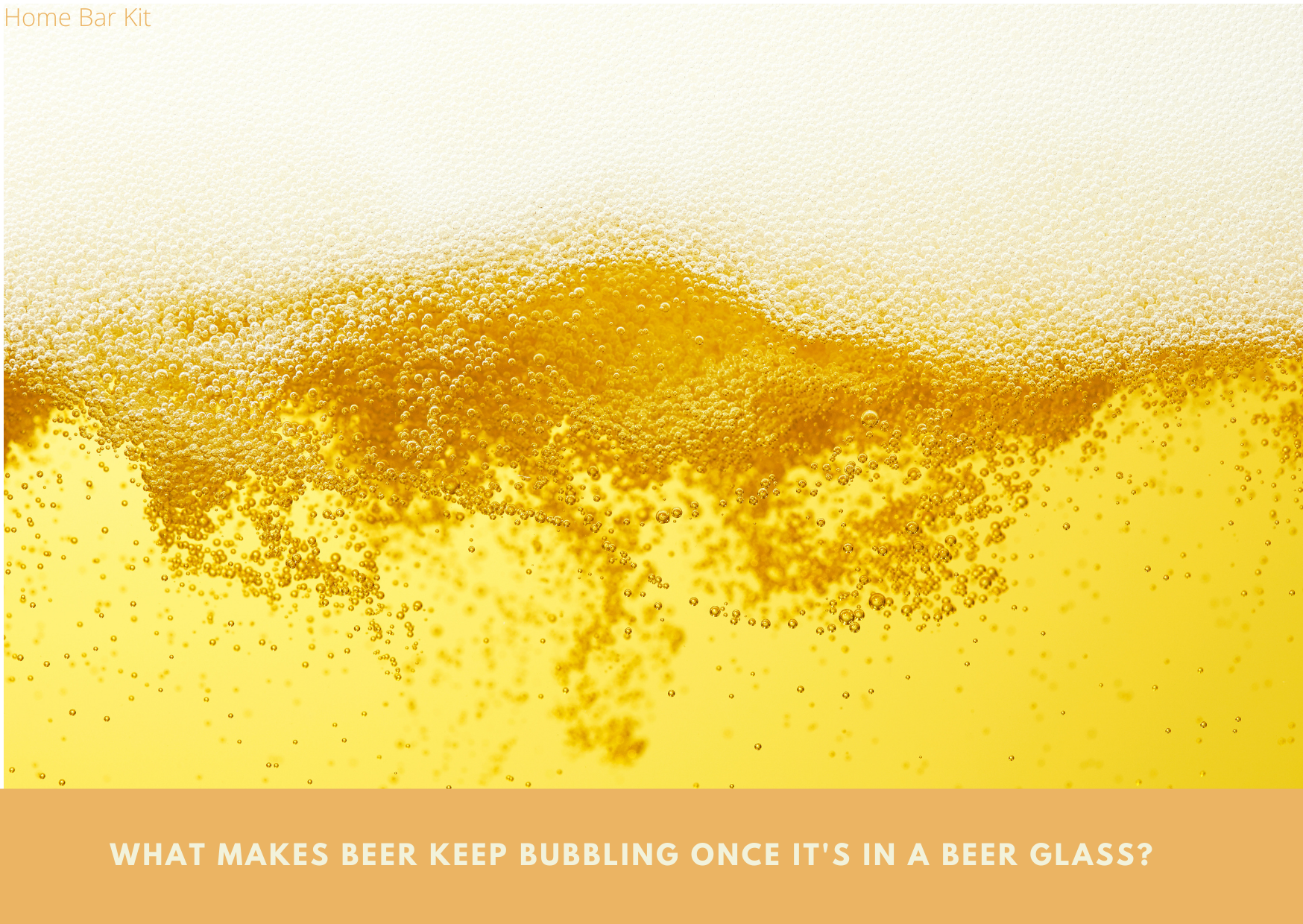We have all observed the bubbles in our beer rising like a helium balloon floating up into the sky. When the beer is first poured there is a surge of bubbles that rise to the top and form a white foamy head.
The head will differ in size depending on how aggressively the beer has been poured into the glass. Poured gently at an angle and the head will be slight. Poured into an upright glass and the head will be a lot deeper. As the beer settles the bubbles calm and the head will decrease to a thin top.
Carbon Dioxide is the gas that produces the bubbles in the first place. It is waiting silently to be released, which happens when we open a bottle or can of beer. Nucleation points are what form the bubbles and those bubbles eventually break from the nucleation points. These bubbles rise in a steady stream to the top of the glass. A nucleated glass will keep beer bubbling in the glass.
The bubbles can enhance the beers aroma and flavor.
What Makes Beer Fizz In The Glass?
As I said carbon dioxide is the gas that is responsible for the fizz in beer. It is known as carbonation and there is a certain amount of natural carbonation formed during the brewing process. But carbonation can be added to a beer too, this is known as forced carbonation.
The amount of carbon dioxide added will depend on the style of beer, a lager being higher in carbonation than an ale. It is kept in the beer by sealing the beer into a bottle or can. The beer is then under pressure and the carbon dioxide will stay in the beer. Once opened the gas is released and tiny bubbles are formed which rise to the top.
This gives us the perfect display of fizz in our beer and forms the delightful foamy head. If you want to go more in depth into beer carbonation, Mammoth Beer explains it well in an article entitled ‘How Brewers Carbonate Beer‘. It explains the different methods used by breweries to carbonate their beer.
If you would like to go even deeper on a science trip then ‘Henry’s Law‘ will fry your head. It is used to perfect the gas absorbed in liquid, or in this case beer.
Nucleation

This is the art of constant flowing bubbles in your beer, this is what keeps those bubbles rising to the top. There is negative and positive nucleation when it comes to that beer in your glass.
First off, what does nucleation actually mean? Trying to explain it didn’t go well, so I borrowed a paragraph from the dictionary, it’s just easier.

Now that’s clear. lets move on.
Negative nucleation can take place when we pour beer into an imperfect or dirty glass. If a glass has scratches or the internal surface is not smooth, then the bubbles are formed around these imperfections. When the bubbles get big enough they will break away and rise to the top.
This also goes for a dirty glass, whether it be grease residue or tiny specks of food from dish water. Or any other dirt on the inside of the glass. Bubbles will form until they are big enough to break away. A sure tell tale sign is when you see bubbles clinging to the inside of the glass.
Any imperfection or dirt inside a glass will create nucleation points and can ruin the beer experience. To find out more about how clean your beer glasses are read ‘Why Is My Beer Glass Dead’.
These are negative nucleation points in a glass, so what are positive nucleation points?
What Are Nucleated Beer Glasses?
A positive nucleation in a beer glass is man made, it is creating a nucleation point for a constant flow of bubbles. This is done by etching a small area at the bottom of the glass. It can be a simple pattern or a breweries logo, but the result is the same.
The etching creates an imperfection at the bottom of the glass and this forms the bubbles. As they grow they release and flow to the top of the glass. There will be a constant flow of bubbles flowing from the etched pattern to the head.
The video shows a nucleated glass in action up against a normal glass.
Visually it looks good, the beer looks alive and the opposite of being flat. The bubbles help to keep the head alive and kicking which in turn releases the aromas as you drink. The head retention will leave a lacing around the glass as you drink it. In essence a nucleated beer glass is keeping your beer refreshed as if it had just been poured.
If left long enough any beer will lose its carbonation and go flat. With a nucleated glass this will happen quicker, it speeds up the release of the CO2. A Nucleated glass does not produce more carbonation than a normal glass, it just releases it quicker. Unless you take an hour or more to drink your beer, then this should not be an issue.
Many breweries design nucleated glasses to to be paired with certain beers. They want us to enjoy the beer the way they intended it to be. A dirty glass though will ruin this enjoyment, so make sure your glass is clean whether it is nucleated or not.
Final Thoughts
If you love those bubbles, then get a set of nucleated glasses and test your favourite beer in one compared to a normal beer glass. You will soon know which one you prefer, but it will change your beer experience.
Nucleated glasses are nothing new, they have been around for a long while now. Although not everyone knows about them even though they may have drunk from one. Even if you are familiar with them, it is worth having your own set because some beers are better enjoyed with one.
Experiment with a few different beers using a nucleated beer glass and share your thoughts below.
Rob is a passionate home bar and pub shed enthusiast with a passion for craft beer. With hands-on experience in designing and building his own home bar, Rob shares his knowledge, tips, and inspiration to help fellow enthusiasts create their own perfect space. Alongside the world of home bars and pub sheds, Rob also explores the diverse and exciting realm of craft beer, providing honest reviews to help you discover your next favorite brew. Join Rob on a journey of flavor, design, and craftsmanship right here on Home Bar Kit.

